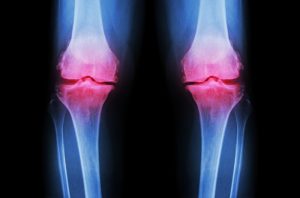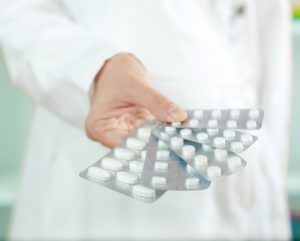Everything about the role of inflammation in the joints
Rheumatoid arthritis is accompanied by chronic inflammation of the joints. But even in osteoarthritis, the role of inflammation cannot be underestimated. These “fireplaces” can only damage the cartilage further. Fighting inflammation is therefore the best method of protecting the remaining cartilage against further degeneration. This not only reduces pain and stiffness, but it can also help to delay a joint replacement surgery (for example knee or hip).
What is an inflammation?
The body responds to an inflammation when tissues are damaged or when foreign substances have invaded. The main purpose of the inflammation is to remove the harmful bacteria, viruses or fungi in order to make any recovery possible. This assignment is performed by white blood cells and immune proteins. However, an inflammation can also be the result of autoimmune disease. ‘Auto-immune’ means that the immune system turns against its own body. Something goes wrong when cleaning unnecessary cell remnants. Instead, well-functioning cells are attacked. Rheumatoid arthritis, Bechterew‘s disease, Sjögren’s syndrome, Mixed Connective Tissue Disease (MCTD), Lupus erythematosus (LE), and Arthritis Psoriatica are rheumatic diseases classified as autoimmune disease.

What are the symptoms of an inflammation?
The most important and perhaps most annoying symptom is pain. With an inflammation, the body will increase blood supply to the affected area. The blood vessels are dilated enabling the white blood cells and immune proteins to better reach the endangered site. This causes the skin to feel red and warm. There is also a swelling that increases the pressure on the surrounding tissues. This stimulates the nerves, causing pain. In a normal situation, these measures of the body are sufficient to detoxify viruses, bacteria and fungi. In rheumatoid arthritis, this is not the case because the immune system continues to attack the healthy cells around the joints. As a result, the inflammations remain chronically present. With osteoarthritis, the abrasive cartilage causes continuous irritation, which may lead to new inflammation.
How is an inflammation treated?
Both in rheumatoid arthritis and osteoarthritis there is emphasis on fighting the inflammation. Its purpose is to dampen the pain and prevent further damage to the joints. In mild to moderate pain, a simple agent like Paracetamol may help to reduce the symptoms. If this does not help, the doctor may prescribe NSAIDs. These anti-inflammatory analgesics are effective, but the effect is short lived. The disadvantage of this medication is that it often presents with annoying side effects. The classical NSAIDs also inhibit the action of an enzyme (COX-1) that has a protective effect on the gastrointestinal tract. As a result, complaints such as inflammation of the gastrointestinal mucosa, nausea, vomiting and even stomach ulcers may occur with bleeding. The modern NSAIDs have no inhibitory effect on COX-1, but it is still unknown whether these drugs are really safe. A corticosteroid injection also has the ability to treat very specific inflammations of the tendons and joints. In rheumatoid arthritis your doctor may prescribe DMARDs. These are classical rheumatoid inhibitors that suppress the inflammations in the joints.
Are there natural remedies against inflammation?
According to US experts, there are clear indications that an adjustment of the food pattern may lead to less inflammation. Fatty fish like mackerel, herring and salmon contain many omega-3 fatty acids, which have anti-inflammatory action. Green vegetables, nuts and fruits also contain many of these beneficial fatty acids. In addition, there are some plant products with anti-inflammatory action. Ginger for example. If you suffer from joint disease, drinking an alcohol-free ginger can cause some relief. Curcumin is also such a typical herb with a beneficial effect on the joints. Unfortunately, this inflammatory inhibitor is very difficultly absorbed by the body. Devils claw or Harpagophytum procumbens would also have an analgesic and anti-inflammatory action. This also applies to Blackcurrant leaf.
In addition, in The Netherlands, the liquid Green-lipped mussel is getting more popular as an anti-inflammatory inhibitor in joint complaints. According to the “Moving Without Pain” foundation, liquid Green-lipped Mussel with Bio-Curcumin and Blackcurrant leaves remains the most effective natural anti-inflammatory inhibitor currently available. This drug works satisfactorily in 70 percent of people with osteoarthritis or rheumatoid arthritis within 80 days. Because the intact Green-lipped mussel has been liquefied via a special process, it contains anti-inflammatory proteins and furan fatty acids as well as Omega-3 fatty acids. As a result, this liquid joint cure works better than the dry powder from the Green-lipped mussel or a Green-lipped mussel extract. These contain only a part of these anti-inflammatory components. By adding a well-absorbable Bio-Curcumin (BCM-95®) plus Blackcurrant leaf, this liquid agent has a wide and effective effect on inflammation of the joints.

Share this page
Tweet

Download for free the booklet ‘Moving without pain’ with a retail value of $6.75 / £4.95.
Any questions? Please feel free to contact us. Contact us.






